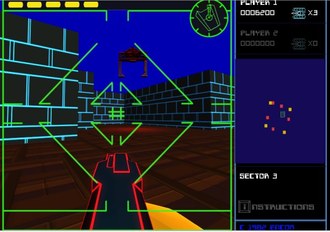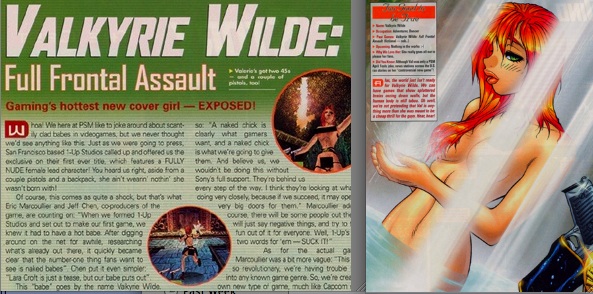The 10 Greatest Fictional Videogames
 |
?Videogames occupy a strange place in fiction. They’re often used to symbolize escapism and perhaps supply some belabored commentary about the borders between the real world and the virtual. For we devoted geeks, however, these fake videogames really just show us all sorts of cool things that actual video games can’t do. Yet.
We’re also beset with games invented by cruel developers or snide magazines, who fooled untold numbers of readers into thinking that there really would be a Mario-based Kingdom Hearts or a Lord of the Rings go-kart racer for the Sega Neptune. For the sake of these broken promises, we’re here to point out the most memorable non-existent games seen in films, books, and pranks over the years. A few even became actual games, proving that truth is stranger than Tron.
10) Leisure Suit Larry 4: The Missing Floppies
The Leisure Suit Larry series could be a prank in itself: a line of adventure games that play like King’s Quest, only instead of guiding a young hero on an adventure full of elves and chalices, you’re playing a horny, middle-aged loser who’s just trying to get laid. But the Leisure Suit Larry games are real, and they were smash hits for Sierra and creator Al Lowe back in the 1980s. Well, they’re real with the exception of Leisure Suit Larry 4.
The third Leisure Suit Larry ends on a particularly strange note: sad-sack hero Larry Laffer and his one-true-girlfriend Passionate Patti escape a cannibal attack by breaking through the fourth wall entirely and roaming the halls of Sierra, where they race by the sets for Police Quest, Space Quest, and King’s Quest. Eventually, Sierra offers Larry his own game, letting him retire to the countryside. And then Leisure Suit Larry 5 picks up with an amnesiac Larry working for mobsters while Patti roams around with the FBI.
So what happened to Leisure Suit Larry 4: The Missing Floppies? It was skipped partly to give Lowe a chance to reboot the series with the fifth game, with the titular missing disks causing Larry’s memory loss. Then again, Sierra was working on a never-released fourth Larry game, a multiplayer title for the fledgling Sierra Network. The game was canceled, and the most Sierra Network users saw of Larry was a casino named after him.
Is it real now? Nope. Granted, there’s always the opportunity to go back and make the fourth Leisure Suit Larry game properly. But before you wish for that, consider how the most recent Larry, Box Office Bust, turned out.
9) Arcade
Evil games were staples of horror back in the 1980s, when video arcades were new and lazy writers could get away with the idea of human brains hijacked by the insidious technology of Pooyan. Those fears abated in time, but monstrous games were revived in the 1990s by another concept: virtual reality. And while A Really Butchered Version of Stephen King’s The Lawnmower Man is the most prominent example of this mercifully short-lived trend, it’s Albert Pyun’s Arcade that captures the whole idea in low-budget style.
What makes Arcade stand out? Well, there’s the concept: a hot new game takes over the minds of eager teenage players because it was made from a dead child’s brain cells. There’s also the cast, which includes Peter “Ralphie from A Christmas Story” Billingsley, John “Q from Star Trek” de Lancie, and Seth Green somewhere between It and SeaQuest 2032. And then there’s the game itself, a virtual cornucopia of computer-rendered deathtraps that wouldn’t have flown in an early episode of ReBoot.
Is it real now? Nope. Virtual reality itself wasn’t as hot of a trend as movies had us believe, and while Arcade has its fans, none of them cares enough to program a fully functional version of the game.
8) Bonestorm
Every TV comedy worth its salt attempts a video-game parody, from Red Dwarf‘s Better than Life to Aqua Teen Hunger Force‘s Video Ouija. Even so, it’s hard to deny that The Simpsons defined the 1990s game parody, just as it defined so much before its inevitable fall in quality. The Episode? “Marge Be Not Proud.” The game? BoneStorm.
BoneStorm is essentially Mortal Kombat, with imitation Goros squabbling onscreen during a totally in-your-face commercial. Bart is, of course, enraptured by this media manipulation, to the point where he steals a copy of BoneStorm. Everything works out in the end, and Bart gets another hot new videogame for his Christmas present.
The script includes numerous mockeries of popular games, and it even mentions an unpopular one by accident: a spoiled kid tells his mother that he already has BloodStorm, the name of a hilariously violent Mortal Kombat rip-off from 1994.
Is it real now? Nope, though BoneStorm 2 is mentioned in The Simpsons: Hit and Run.
7) Valkyrie Wilde: Full Frontal Assault
Game magazines love their April Fool’s jokes, and the best such pranks capture the shameful zeitgeists of their own little gaming eras. The best-known is EGM‘s 1992 revelation that players could fight Sheng Long, Ken and Ryu’s supposed master, in Street Fighter II. It embodied both the fighting-game craze and the gullibility of a generation that seized on any minor possibility of secrets in games (the “Sheng Long” mentioned in Street Fighter II is just a mistranslation of Ryu’s Shoryuken move). And then Capcom went and put Ken and Ryu’s master in Street Fighter IV, albeit under his proper name of Gouken.
Games moved on, and by the end of the 1990s, the most bandied-out rumors among kids were… well, they were all about Pokemon. But the second most popular rumors had to do with Tomb Raider, and the persistent talk that a cheat code could make star Lara Croft naked. This was a lie, but the unauthorized PlayStation rag PSM exploited this fantasy with an April mock-up all about Valkyrie Wilde: Full Frontal Assault.
 |
?Some of PSM‘s writeup gives away the joke, pinning an April 1st release date on the game and revealing its developers to be unabashed about their Tomb Raider rip-off. On the other hand, some of it’s depressingly plausible, considering what was being made in the game and comic-book industries at this point. Valkyrie Wilde apparently goes naked but for her boots and handgun holsters just so she can distract security guards. How clever.
Is it real now? No, and it thankfully never will be. However, PSM had artist Adam Warren draw Valkyrie Wilde for a swimsuit issue (yes, one about non-existent game women) several years down the road.
6) Killswitch
The Internet is full of game geeks with excessive amounts of spare time, so we shouldn’t complain when some of them turn to creative writing. Lots of websites indulge themselves in devising games that never were, but there’s one that stands out as bizarrely fascinating: Killswitch.
No, this isn’t the Killswitch that Namco released in 2003 and immediately forgot about. This is a Killswitch detailed on the Invisible Games website, a now-defunct chronicle of made-up software. Killswitch is the most interesting of the bunch, as a puzzle-based adventure where players help either an injured woman named Porto or an invisible demon named Ghast in escaping a mine full of strange creatures and possessed humans. The game’s story reveals that it’s all the aftermath of a hellish uprising among the workers, but the truly interesting part is its copy protection. As the website puts it:
“Killswitch, by design, deletes itself upon player completion of the game. It is not recoverable by any means, all trace of it is removed from the user’s computer. The game cannot be copied. For all intents and purposes it exists only for those playing it, and then ceases to be entirely. One cannot replay it, unlocking further secrets or narrative pathways, one cannot allow another to play it, and perhaps most importantly, it is impossible to experience the game all the way to the end as both Porto and Ghast.”
Of course, a real game with such parameters would be hacked and dissected to no end, but it’s fun to dream now and then. Even when that dream ends with sobbing, insecure Japanese men.
Is it real now? Not yet. Give it a few more years of buildup.
—-
5) Fire Starter
FLCL is the sort of crazed, in-jokey anime comedy that’s usually annoying and horrible. But this is the exception that proves the rule, for FLCL is magnificently bizarre nonsense with an actual, honest theme of maturity powering the guitar fights, the South Park references, and the robots that burst out of a boy’s head. In this chunk of self-indulgence that studio Gainax created partly in reaction to their own grim and depressing Evangelion, just about every character has a hang-up, and one involves a handheld game called Fire Starter.
Mamimi is the clingy, distracted ex-girlfriend of main character Naota’s absent older brother, and she’s never had it easy. So she takes temporary refuge in Fire Starter, a simple game where players sow blazes throughout an ever-growing city of demons, gathering simple tools of arson to appease the god of black flames. It’s a depressingly nihilistic little endeavor; as Naota points out, you can’t really win. That’s fine with Mamimi, who soon gives up the game to worship an easygoing robot as her new pyromaniac god. And then there’s the fact that her school just happened to burn down when she was a kid…
Is it real now? Yep. Fans made a downloadable version of the game, one that mimics the greenish Game Boy graphics of the Fire Starter seen in FLCL itself.
4) Polybius
Polybius is simply too interesting to be real. As the story goes, this enigmatic game debuted in Portland arcades in the early ’80s and proved quite popular. Yet the game’s dizzying graphics gave players nightmares, headaches, and suicidal fervor. And, like any good conspiracy, it was the government’s fault. Unidentified men in black stopped by arcades to gather data from Polybius machines, and the game was pulled from location testing just when people started to get suspicious.
Of course, there is not one single image or halfway convincing piece of evidence that Polybius ever existed. It’s just a mixture of Cold-War nerves and a few actual cases of flashing games giving players epileptic seizures. And that’s why the myth of Polybius shows up everywhere from Simpsons episodes to gullible game-geek hangouts.
Is it real now? No legend as pervasive as Polybius could go on without inspiring a few game designers. Some pranksters released a non-working version of the game years back, and the developers at RogueSynapse put out their own light-show version of Polybius. Stare at it too long and you might get a seizure after all.
3) Lucky Wander Boy
 |
?D.B. Weiss’ Lucky Wander Boy is the Great American Videogame Novel pretty much by default, but it deserves more than such faint praise. It’s a funny and frequently insightful journey through a swamp of nostalgia, lowest-common-denominator entertainment, and the art of overthinking things. The book finds young slack-off writer Adam Pennyman rediscovering his love of old Centipede-era arcade games. As he sulks through a job at a crumbling, exploitive venture-capital empire, Pennyman analyzes the games of a simpler age, discussing the Gnostic elements of Donkey Kong and the nature of Pac-Man‘s reality. Our hero’s self-centered fixations have warped his career and his views of women, but he’s after something he considers much more important: an obscure game called Lucky Wander Boy.
An expensive, short-lived arcade bomb, the Lucky Wander Boy game starts off as a regular, jump-and-dodge affair similar to Donkey Kong or Popeye, with the first three boards growing increasingly hard and abstract. Then players find themselves in the second world: a vast, graphically impressive desert where Lucky Wander Boy roams about collecting items and never encountering enemies. There’s a third world that no one apparently ever reached, but Adam Pennyman came so, so close when he was a kid. Now he’s obsessed, and the truth about Lucky Wander Boy is either hilarious or transcendent, depending on which of the book’s fractured endings you believe.
Is it real now? Sadly, no one’s made an actual Lucky Wander Boy game, not even as some lazily reworked Donkey Kong hack.
2) Space Paranoids
The original Tron may be a bland movie once you get over the glowing scenery and the intriguing idea of worlds within computers, but it’s got great game material wall to wall. Unfortunately, kids of the 1980s were betrayed by the game technology of their day, which reduced the amazing light-cycle duels of the movie to a bunch of lines whirring around on the screen. And then there’s the disappointment of Space Paranoids.
Well beyond the technology of your average early-’80s arcade game, Space Paranoids is a first-person shooter where the player zaps giant floating warships. While that can’t compete with the later sights of Tron‘s computer world, the movie shows Jeff Bridges playing a Space Paranoids machine right next to Berserk and Space Invaders. Only Space Paranoids looks a lot cooler. But you won’t see it in arcades, kids, at least not for a few decades.
Is it real now? The Space Paranoids of Tron fame looks downright ancient by today’s standards, so it was no trouble for 42 Entertainment to whip up a convincing game for Comic-Con in 2009. It’s just in time for Tron: Legacy to once again show off a round of videogames we won’t properly play until 2037.
1) Starfighter
In the cinema of the 1980s, videogames weren’t just beeping diversions. They were the tools of enlightenment, where being good at an arcade quarter-eater would bring you success, true love, and life-changing revelations. Nintendo’s The Wizard was the last of this kind, but the genre reached its apex years before with The Last Starfighter. It’s the story of a trailer-park kid named Alex Rogan, whose game-playing talents land him on the front lines of an interstellar war, but it’s also the perfect paean to an era where getting a high-score at a game actually meant something.
That game, Starfighter, is just an introduction to the computer-generated space battles and endearingly one-dimensional villains that Alex faces later the movie. It still looks like fun, with digitized voices and a neat targeting display, and Atari even tried to bring a version of it to arcades in the 1980s. But then the game market crashed, and all we had were pitifully scaled-down The Last Starfighter shooters. In fact, the one for the NES was just a re-branded Commodore 64 game called Uridium.
Is it real now? Yes. Rogue Synapse came to the rescue several years ago with a full-blown Last Starfighter game, accurate down to the opening narration about Zur and the computer-rendered Ko-Dan Armada.
